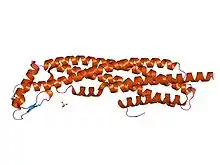Haemolysin E
Haemolysin E (HlyE) is a protein family that consists of several enterobacterial haemolysin (HlyE) proteins. Hemolysin E (HlyE) is a novel pore-forming toxin of Escherichia coli, Salmonella typhi, and Shigella flexneri.
| Haemolysin E (HlyE) | |||||||||
|---|---|---|---|---|---|---|---|---|---|
 Structure of E. coli hemolysin E toxin.[1] | |||||||||
| Identifiers | |||||||||
| Symbol | HlyE | ||||||||
| Pfam | PF06109 | ||||||||
| InterPro | IPR010356 | ||||||||
| SCOP2 | 1qoy / SCOPe / SUPFAM | ||||||||
| TCDB | 1.C.10 | ||||||||
| OPM superfamily | 198 | ||||||||
| OPM protein | 2wcd | ||||||||
| |||||||||
HlyE is unrelated to the well characterised pore-forming E. coli hemolysins of the RTX family, haemolysin A.
HlyE is a protein of 34 kDa that is expressed during anaerobic growth of E. coli. Anaerobic expression is controlled by the transcription factor, FNR, such that, upon ingestion and entry into the anaerobic mammalian intestine, HlyE is produced and may then contribute to the colonisation of the host.[1]
References
- Wallace AJ, Stillman TJ, Atkins A, Jamieson SJ, Bullough PA, Green J, Artymiuk PJ (January 2000). "E. coli hemolysin E (HlyE, ClyA, SheA): X-ray crystal structure of the toxin and observation of membrane pores by electron microscopy". Cell. 100 (2): 265–76. doi:10.1016/S0092-8674(00)81564-0. PMID 10660049. S2CID 1793308.
This article is issued from Wikipedia. The text is licensed under Creative Commons - Attribution - Sharealike. Additional terms may apply for the media files.